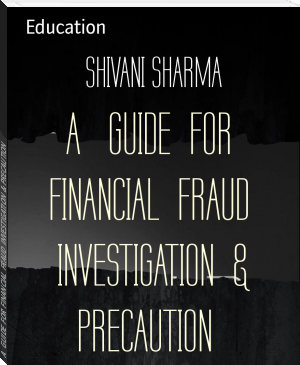A GUIDE FOR FINANCIAL FRAUD INVESTIGATION & PRECAUTION, SHIVANI SHARMA [read my book txt] 📗

- Author: SHIVANI SHARMA
Book online «A GUIDE FOR FINANCIAL FRAUD INVESTIGATION & PRECAUTION, SHIVANI SHARMA [read my book txt] 📗». Author SHIVANI SHARMA
An unintended consequence of poverty alleviation initiatives can be that loan sharks borrow from formal microfinance lenders and lend on to poor borrowers.[8] Loan sharks sometimes enforce repayment by blackmail or threats of violence. Historically, many moneylenders skirted between legal and criminal activity. In the recent western world, loan sharks have been a feature of the criminal underworld.
Insider trading is the buying or selling of a publicly traded company's stock by someone who has non-public, material information about that stock. Insider trading can be illegal or legal depending on when the insider makes the trade. It is illegal when the material information is still non-public. FORGERYA forgery is a criminal act that takes place when a person falsifies something with the intent to deceive another person or entity. There are many kinds of forgery, but all are considered crimes in the United States. Forgery has a long history, but it became more common in the 20th century as technology has made it easier for criminals to commit the act. Some cases throughout history have been so remarkable that the forged pieces are on display in popular museums around the world. To explore this concept, consider the following forgery definition
Definition of Forgery
Noun. A crime that involves making to altering writing with the attempt to defraud another person or entity Noun. The production of fake art or other works that a person claims are genuine fabricating. Noun. The act of devising, fabricating, or counterfeiting a document or other object.Origin Middle English forge
Elements of Forgery
In order for the judicial system to charge a person with forgery, certain elements or factor must be in place. If one or more of the elements is missing, it can result in different charges.
Making, Altering, Using or Possessing a Forged Item
In forgery cases, the individual must have made, altered, used, or possessed false writing at some point in time. This is not just limited to writing letters or documents as altering existing documents is also forgery if it is done in an attempt to gain or deceive another person. This includes changing or adding the signature on a document, but also includes deleting it. Using or possessing false writing is also considered forgery, though some states consider it “uttering false writing.”
Legal Efficacy
Not every altered document or letter falls within the bounds of forgery. In order for an altered document to be subject to forgery laws, false writing must have legal significance. This includes, but is not limited to:
Government-issued identification Deeds Conveyances Checks Stock certificates Patents Wills Prescriptions Other medical documentsMaterial Alteration
In order for the writing to fall under the definition of false, the material included must have been fabricated or altered significantly in order to represent something it is actually not. For example, if a person changes the will of another person to benefit himself, it is considered forgery. If a person inserts a false statement into a letter, but it does not change the meaning of the letter, it does not fall under the category of forgery.
With the Intent to Defraud
Simply falsifying a letter or document does not constitute forgery unless the person does so in an attempt to defraud a person or entity. Under this element, simply possessing a forged document does not constitute forgery if the person with possession does not know that the document is false. For example, if you were to receive a check for a car you sold and the check was forged, you would not be held criminally liable unless you knew that the check had been falsified. If you knew that the check was forged, this constitutes fraud in many states.
Types of Forgery
There is a wide range of documents that can be forged, but some are more common than others. Some of the most types of forgery involve signatures and prescriptions.
Signature Forgery
Signature Forgery is the act of replicating another person’s signature. In signature forgery cases, criminals use many methods, including tracing. When examining a document that is suspected of being falsified, there are experts that can examine the signature to determine if it is indeed forged. Some common signs of forged signatures include:
Shaky handwriting Signs of retouching Size of signature Pens liftsPrescription Forgery
Prescription forgery is a serious criminal offense and involves forging a doctor’s signature or the entire prescription in order to gain prescription medications, namely controlled substances. Since prescription forgery is becoming more and more common, some pharmacies contact the doctor that allegedly prescribed the medication before filling it.
Art Forgery
Art forgery consists of taking a piece of art and adding an artist’s name in order to pass it off as a genuine piece. A person can create the art piece themselves and add a false signature, or they can use an existing piece and add the signature. Art forgery can result in serious charges if the art is sold for a large amount of money.
Federal Forgery
Most commonly, forgery is charged and prosecuted at the state level; however, certain types of forgery are considered federal forgery crimes. This includes, but is not limited to:
Changing or altering government issued identification Changing or altering other documents in an attempt to steal another’s identity Changing or altering military issue documents Changing or altering immigration documents Changing or altering any other items in an attempt to defraud the federal governmentA person can also be subject to federal forgery charges if they mail, or carry falsified writing across the state, or international borders. The same is also true if a person has been found to commit forgery in multiple states.
Affidavit of Forgery
An affidavit of forgery is a legal document completed by a victim of fraud. Financial institutions and police departments often have the victims fill out the form and have it notarized. The affidavit of forgery acts as a sworn oath that the documents in question have been falsified. The form is used during the civil or criminal court proceedings. The affidavit of forgery is also used to help victims recover losses that occurred as a result of the forgery crime. For example, if a person notices that some is using their checkbook and forging their signature, they can fill out an affidavit in order to regain the money taken from their account.
Common Forgery Punishment
In all states, forgery is considered a felony, and the punishments range greatly. Some common forgery punishments include prison time, fines, probation, and restitution. While state forgery laws have minimum and maximum punishments in place for forgery, the judge often determines the punishment. The judicial system often considers certain things during the sentencing portion of a criminal trial including:
Defendant’s criminal history The type of document What the defendant gained or attempted to gain with the forgery Whether the defendant has attempted to right his wrongSome states rely mostly on the type of document in question specify forgery punishment according to the severity of the forgery crime. For example, in New York, different degrees of forgery are in place depending on the document used during the crime.
First-degree forgery: currency, securities, stocks, bonds Second-degree forgery: deeds, government-issued IDs, public records, prescriptions Third-degree forgery: any other type of documentFinding a Forgery Attorney
When a person has been charged with forgery, they should consider hiring a criminal defense attorney as soon as possible. An attorney with experience in dealing with forgery can help the person understand forgery laws in the state, go over the evidence that the prosecuting attorney has, and help explain the options available. An attorney can also help a person charge protect his rights before, during, and after the court, the proceeding has taken place. While hiring a lawyer can result in high costs, it is important to consider the benefits of facing the judicial system alone can be daunting and detrimental.
Forgery Cases
Forgery occurs within the United States on a daily basis, but some forgery cases have made national headlines to their severity. Some of the most famous cases of forgery involve art.
The David Stein Forgeries
In the 1960s, David Stein made a living traveling from city to city, selling paintings that he claimed were done by European masters. Since the artists’ signatures were in place, many people fell for the scam. In 1967, one of these artists, Marc Chagall, saw three paintings in a New York City gallery containing his name. He knew these were not his works and he contacted the police. Stein was arrested and spend 22 years in jail. Unfortunately, shortly after his release, he was back to selling fake works of art.
Howard Hughes’ Autobiography
In 1970, a reclusive tycoon named Howard Hughes was the victim of forgery. Due to his isolated lifestyle, he was an easy target for Clifford Irving. Irving, an ordinary man, contacts publishing companies claiming that he had a letter signed by Hughes giving him permission to write his biography. McGraw-Hill, a famous publishing company paid Irving $765,000 to write the book. Irving boldly began writing it, believe that Hughes would never find out since he suffered from a mental disease, and never left his home. Irving was in for a shock two years later, however, as Hughes held a conference letting the world know that he did not know Irving and never gave him permission to write his biography. Irving was arrested and spent 17 months in prison.
LOAN SHARKINGUnited States[edit]19th-century salary lenders[edit]
In the late 19th-century US, the low legal interest rates made small loans unprofitable, and small-time lending was viewed as irresponsible by society. Banks and other major financial institutions thus stayed away from small-time lending. There were, however, plenty of small lenders offering loans at profitable but illegally high interest rates. They presented themselves as legitimate and operated openly out of offices. They only sought customers who had a steady and respectable job, a regular income and a reputation to protect. This made them less likely to leave





Comments (0)